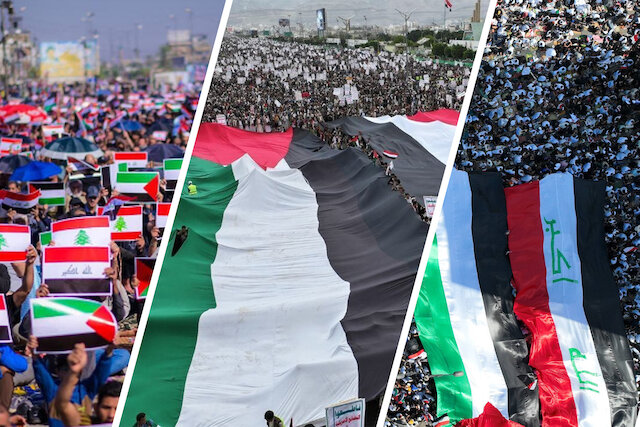“Iran’s Proxy Forces:” A label to diminish national and religious resistance

West Asia, as one of the world’s key geopolitical hotspots, has long been a theater of extensive struggles against colonialism and imperialism. These struggles are rooted in the region’s deep history of resistance, where its people have stood firm against oppression by foreign and domestic powers. In this context, the Leader of the Islamic Revolution, in his Eid al-Fitr sermon on March 31, 2025, stated:
In the political statements made in the West, you’ve repeatedly heard them talk of proxy forces. They accuse the brave nations and valiant youth of this region of being proxies. I want to tell you that there is only one proxy force in this region and that’s the evil, usurping Zionist regime. The Zionist regime in acting as a proxy for the colonialists, ignites fires, commits genocide, and perpetrates crimes.
While some American and Western leaders portray Resistance groups in the region as Iranian proxies, historical reality shows that resistance in West Asia predates recent developments — even preceding Iran’s 1979 Islamic Revolution. In truth, it stems from anti-colonial and anti-imperialist struggles.
From Ahmed Urabi’s resistance in Egypt to the resistance movements in Palestine and Yemen, this region has consistently witnessed the defiance of free-spirited people against oppression. Western claims of proxy ties between Resistance groups and Iran are not only false but also an attempt to distort history and obscure the fact that the Zionist regime itself is the true proxy — serving the interests of Western colonial powers. Thus, Resistance in West Asia continues the legacy of those who fought for their nations’ independence and freedom, a struggle that will persist until justice and liberation are achieved.
Part 1: A history of resistance against colonialism and imperialism
Throughout history, resistance to colonialism and imperialism has been a natural response by free people against oppression. Wherever nations or powers have sought dominance, resistance movements have risen to defend independence and freedom. This struggle is not unique to West Asia; examples of anti-colonial resistance exist worldwide.
In South America, Che Guevara became a symbol of resistance against US imperialism, leading Cuba’s revolution alongside Fidel Castro. In South Africa, Nelson Mandela endured years in prison as a leader of the anti-apartheid movement, fighting for social and political justice. In Algeria, Larbi Ben M’hidi resisted French colonialism, ultimately securing Algeria’s independence. In India, Mahatma Gandhi waged a prolonged struggle against British rule, leading to India’s freedom.
These examples demonstrate that resistance to colonialism and imperialism is a global phenomenon. In every era, free people have stood up for their rights and their nations. West Asia is no exception, with a long history of anti-colonial struggles.
Part 2: Resistance in West Asia before Iran’s Islamic Revolution
As previously noted, the US accuses Resistance forces of being Iranian proxies. Yet, long before Iran’s 1979 Islamic Revolution, West Asia witnessed the rise of resistance groups fighting colonialism and imperialism. These groups opposed foreign powers like Britain, the US, and the Zionist regime, striving for their nations’ independence and freedom.
In Egypt, Ahmed Urabi is recognized as one of the pioneers in the struggle against British colonialism. In the late 19th century, he led a nationalist movement opposing British influence in Egypt and demanding the country’s independence.
Similarly, during the 1920 Iraqi Revolution (Thawrat al-Ishreen), the Iraqi people rose up against the British occupation of their land, waging a determined struggle for their nation’s sovereignty.
In Palestine, resistance against Zionist occupation began in the 1950s and 1960s. The Fatah movement, one of the oldest Palestinian nationalist organizations, was founded in 1959 and waged armed struggle against the Zionist regime. Similarly, the Arab Liberation Front (ALF) in Lebanon, formed in the mid-1960s, continued the fight against Zionist occupation. In Syria, the National Front sought independence from foreign influence and opposed the Zionist regime.
These movements prove that resistance in West Asia existed long before Iran’s Islamic Revolution, rooted in anti-colonial and anti-imperialist struggles. The 1979 Revolution, with its anti-imperialist stance, became a successful model for resistance groups, and the establishment of the Islamic Republic created conditions for their growth and expansion.
Part 3: Western claims about Resistance groups and Iran’s role
In his Nowruz speech of 1404 AHS [March 21, 2025], the Leader of the Islamic Revolution stated:
US and European politicians and others like them make a big mistake by labeling the centers of Resistance in the region “Iran’s proxy forces.” They’re insulting the Resistance. Why do you label them proxies? The people of Yemen have their own reasons; the centers of Resistance in the countries of the region have their own reasons.
As mentioned by the Leader of the Islamic Revolution, in recent years, US and Western leaders have claimed that Resistance groups in West Asia — particularly in Lebanon, Iraq, Yemen, and Palestine — are Iranian proxies. These claims ignore the fact that these groups stem from anti-colonial and anti-imperialist struggles, pursuing their own independent goals.
For example, in Iraq, today’s Resistance groups continue the legacy of early 20th-century fighters who battled British colonialism. Today, they oppose US military presence and demand an end to foreign political interference. In Yemen, Ansarullah — which is fighting Zionist crimes in Gaza and is immobilizing both the US and the Zionist regime in the region — follows the path of Imam Yahya, Yemen’s ruler in 1948, who rejected the partition of Palestine.
The alignment of these groups with Iran is not due to proxy relations but shared beliefs and ideals: the fight against oppression and defense of the oppressed. This principle is evident in the anti-colonial history of these nations. Of course, the Islamic Republic’s support for regional resistance against American and Zionist aggression has been and will remain unwavering. As the Leader emphasized:
Today, nations [worldwide] are of course opposed to and object to the maliciousness being carried out by the Zionist regime, and they show their resistance in any way they can. Anyone who can stands against them.
The Islamic Republic stands firmly against these acts of aggression and maliciousness. We have clearly stated our stance. We support the Palestinian fighters and the Lebanese fighters who defend their country. We support those who defend Palestine and Gaza. This has always been the approach of the Islamic Republic.
In reality, the US and the West, much like their 2003 deception to justify invading Iraq, now use the “proxy” label to mislead global public opinion. They aim to legitimize Zionist crimes while justifying the suppression of Resistance forces in West Asia. Western leaders even label peaceful protests worldwide, including in their own countries, as “anti-Semitic,” just as they lable anti-colonial groups in West Asia as “Iranian proxies” to create divisions and justify military action.
Yet, the people of the region know the truth: These resistance movements are rooted in their historical, national, and religious aspirations for independence and freedom.
| © | KHAMENEI.IR |


